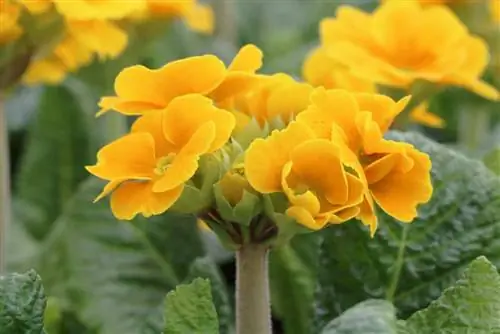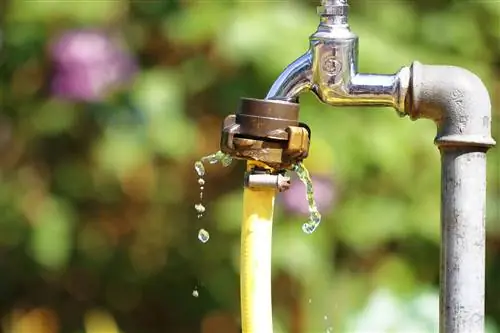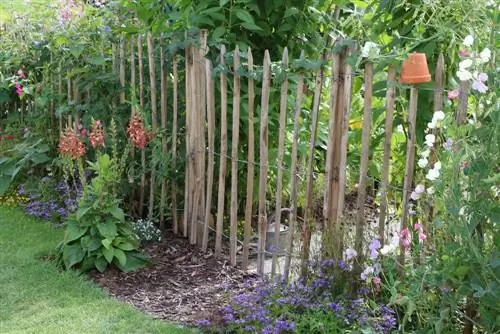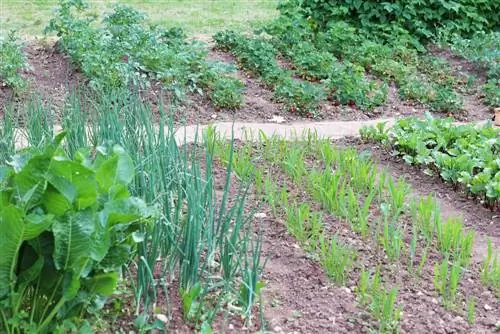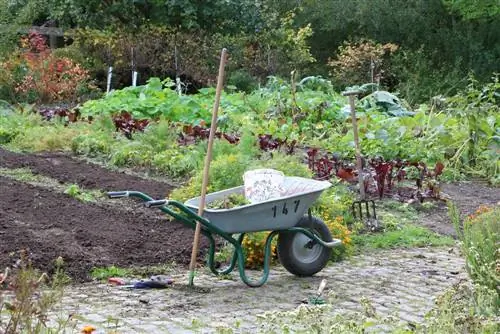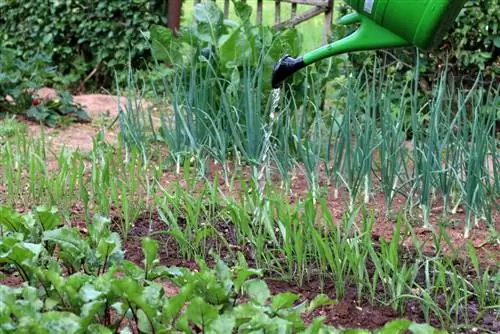- Author admin [email protected].
- Public 2023-12-17 03:39.
- Last modified 2025-01-24 12:45.
Even though some hobby gardeners may have never heard of Primula auricula, this primrose subspecies has a long and interesting history. After roses and tulips went from being a trend to a luxury item and their importance declined, the auricles came into the spotlight. Countless colors were bred and collected, the auricle changed hands at high prices and was even found on paintings and porcelain. For today's gardener, what is most important is easy care and easy propagation.
Location
When choosing the location, it is crucial to know the origin of the auricles. The garden auricle emerged from a cross between the alpine auricle and the primrose and comes from the Alpine region. It is therefore sun-drenched, insensitive to frost and wind and grows on barren, stony and dry soils.
Due to its small height and width, it doesn't even take up much space. A flower pot with a diameter of 12 centimeters is completely sufficient per plant. Whether in a container or outdoors, the roots of the perennial require sufficient downward space as they spread and anchor themselves strongly. The location should therefore look like this:
- sunny, but if possible without the blazing midday sun
- preferably unprotected from wind but with good water drainage
- should not be overshadowed by other plants
For example, a rock garden facing east or west would be ideal, preferably on a slope and only slightly protected from the midday sun. Similar rules apply in container culture or as a potted plant.
Plants
The auricle is a perennial that can easily cope with frost. It can therefore be planted in both spring and autumn. However, the period from September to October is preferable as it blooms very early and can attract attention with its splendid colors in the first spring.
There is nothing special to consider when placing it in the ground. The roots should be covered. If the shoots are already very high, the soil can be piled up a little all around.
Bucket Culture
The auricle is ideal as a potted plant because it does not require a lot of space, can easily change locations and the water supply can be controlled very easily. It was precisely for these reasons that many collectors did not plant the attractively flowering plants in the garden, but instead cultivated them in small pots. As mentioned, a diameter of 12 centimeters per garden auricle is completely sufficient.
However, since the Primula auricula has very long roots, it needs pots that are as deep as possible. Ideally it should be around 20 centimeters. To do this, water drainage must be ensured. The planters should therefore not be placed on a saucer or in a planter. Alternatively, after watering, care must be taken to ensure that no water collects here. A drainage layer at the bottom of the planter provides additional protection against waterlogging.
Repotting
Repotting the Primula auricula should be done every two to three years and can be combined with propagation by division. Although the garden auricle does not necessarily require more space - the planter can be reused straight away - changing the soil is recommended to prevent diseases.
Early autumn should be chosen as the time for repotting. This makes sense at least if the care measure is to be combined with propagation.
Change location
This measure is not necessary in the wild. However, if a change of location is necessary, this can be carried out. The auricle tolerates it without any problems as long as the conditions of the planting site suit the requirements and deep excavation takes place. If the roots are damaged or severely shortened, a he althy Primula auricula can usually recover.
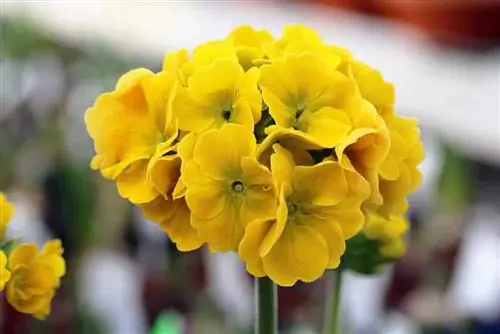
But it requires time and energy, which may be deducted from the flowering power. The best approach is therefore to protect the roots. Suitable times for planting, propagation and repotting are September and October. However, the change of location can also take place in early spring.
Substrate
Barren, dry, loose and permeable - but by no means too nutrient-rich - should be the ideal substrate for auricles. The Primula auricula is very frugal here.
To achieve the loose and water-permeable structure of the substrate, gravel and sand should be mixed in. A simple but high-quality garden soil that does not tend to compact can serve as a basis. This applies both to planting the garden auricle outdoors and to cultivating it in containers.
Pouring
Auricules are particularly easy to care for when watering. Complete drying out should be avoided during growth. But they don't take offense at short dry spells. However, waterlogging quickly becomes problematic and can quickly lead to root rot and the collapse of the auricles.
The Primula auricula is therefore watered carefully, sparingly and only as needed. Rainwater, soft tap water or hard tap water that has been allowed to sit for about a week is ideal. In the latter case, the lime settles on the bottom.
Soft water is absolutely necessary but not for the auricles. Due to their Alpine origins, a higher lime content in irrigation water is not too problematic. The following points are also important when watering the Primula auricula:
- It is better to add small amounts more often, even in dry phases, rather than pour in water
- always pay attention to the drain and urgently avoid waterlogging
- let the substrate dry out before overwintering
- Do not water in winter
Fertilize
Auricles are extremely frugal in terms of nutrient supply - but can quickly be over-fertilized. Therefore, when it comes to fertilizer for Primula auricula, less is more. In fact, the plants don't need to be fertilized at all. They get everything they need from the substrate.
If there is reduced flowering power, reduced growth or discoloration, care errors or an incorrect location are the more likely causes. If these can be ruled out, an earth change should take place.
Bloom
Auricula usually bloom from April to May and bring color to the rock garden or balcony. The withered stands do not necessarily have to be removed. However, if you want to prevent uncontrolled sowing or use the seeds for propagation, you should remove the seed capsules after they have bloomed and dried.
Wintering
Due to their origin, garden auricles are very resilient and have good winter hardiness. They therefore do not need any protection in the wild. Even in a pot it is no problem if the entire ball of soil freezes. However, it should be kept dry beforehand.
From October at the latest, the planters must be placed under them so that they are protected from rain. Alternatively, when cultivating Primula auricula in a pot, it is also possible to overwinter indoors. You can stand dry and very cold. The room does not have to be frost-free. There is no casting in this variant either. An exception is if the plant starts sprouting again in winter. Drying out completely and leaving a room without light doesn't make sense. Light exposure to light and occasional watering may then occur during the winter.
Propagation
Garden auricles can be propagated both by division and by seeds. Propagation is easier via division, as two or even more auricles are immediately available and can be planted out. Seeds, on the other hand, can lead to different offspring and require some patience when sowing and growing, but significantly more young plants can be produced.
Division
If the auricle has spread and is already showing new, unearthly sections, division is recommended for propagation. To do this, the soil is completely removed from the perennial and the roots are rinsed off. The roots are then cut with a sharp knife in the already visible separation areas.
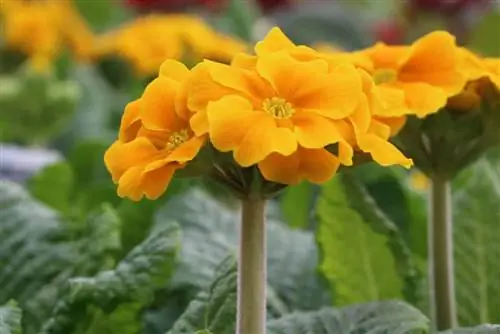
After briefly drying the cut surfaces, the resulting two auricles can be replanted. As mentioned, the ideal time for this type of propagation is between September and October.
Propagation by seeds
After flowering, the seeds form on the auricle. If these are removed, cleaned and stored, there are two sowing options to choose from.
After flowering, it can be sown directly outdoors in the same year, around August. Covered only very lightly or not at all with soil and protected from drying out completely, they sprout comparatively quickly. However, sowing in summer carries the risk that the young plants will not build up enough reserves by winter and will therefore freeze to death.
The safe alternative is to pre-grow the seeds indoors starting in January. However, this variant of propagation is also a little more complex. The procedure is as follows:
- mix commercial potting soil with perlite, sand or gravel to obtain a loose structure
- moisten the substrate slightly
- Apply the seeds of the auricles but do not cover them with substrate because they are light germinators
- place the cultivation container in a bright place and ensure temperatures are between 18 and 20 °C, also use a cover made of foil or a glass pane but ventilate daily
- Keep substrate slightly moist
The first shoots will appear after two to three weeks. If these do not root properly, a little substrate should be carefully crumbled onto the visible roots. As soon as leaf rosettes are visible, they can be transplanted into their own pots. From around March to April, the young plants are allowed outside - as long as they are frost-free.
Conclusion
Auricules are available in numerous colors and pattern varieties, they are easy to care for and propagate and are therefore ideal for beginners in plant cultivation. As long as waterlogging is avoided and the right conditions are provided, the Primula auricula is a lot of fun and requires little effort.

